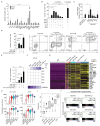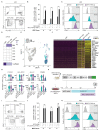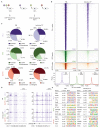Single-cell transcriptional profiling informs efficient reprogramming of human somatic cells to cross-presenting dendritic cells
- PMID: 35245086
- PMCID: PMC7613284
- DOI: 10.1126/sciimmunol.abg5539
Single-cell transcriptional profiling informs efficient reprogramming of human somatic cells to cross-presenting dendritic cells
Abstract
Type 1 conventional dendritic cells (cDC1s) are rare immune cells critical for the induction of antigen-specific cytotoxic CD8+ T cells, although the genetic program driving human cDC1 specification remains largely unexplored. We previously identified PU.1, IRF8, and BATF3 transcription factors as sufficient to induce cDC1 fate in mouse fibroblasts, but reprogramming of human somatic cells was limited by low efficiency. Here, we investigated single-cell transcriptional dynamics during human cDC1 reprogramming. Human induced cDC1s (hiDC1s) generated from embryonic fibroblasts gradually acquired a global cDC1 transcriptional profile and expressed antigen presentation signatures, whereas other DC subsets were not induced at the single-cell level during the reprogramming process. We extracted gene modules associated with successful reprogramming and identified inflammatory signaling and the cDC1-inducing transcription factor network as key drivers of the process. Combining IFN-γ, IFN-β, and TNF-α with constitutive expression of cDC1-inducing transcription factors led to improvement of reprogramming efficiency by 190-fold. hiDC1s engulfed dead cells, secreted inflammatory cytokines, and performed antigen cross-presentation, key cDC1 functions. This approach allowed efficient hiDC1 generation from adult fibroblasts and mesenchymal stromal cells. Mechanistically, PU.1 showed dominant and independent chromatin targeting at early phases of reprogramming, recruiting IRF8 and BATF3 to shared binding sites. The cooperative binding at open enhancers and promoters led to silencing of fibroblast genes and activation of a cDC1 program. These findings provide mechanistic insights into human cDC1 specification and reprogramming and represent a platform for generating patient-tailored cDC1s, a long-sought DC subset for vaccination strategies in cancer immunotherapy.
Conflict of interest statement
Figures







References
-
- Cabeza-Cabrerizo M, Cardoso A, Minutti CM, Pereira da Costa M, Reis ESC. Dendritic Cells Revisited. Annual review of immunology. 2021;39:131–166. - PubMed
-
- Poulin LF, Reyal Y, Uronen-Hansson H, Schraml BU, Sancho D, Murphy KM, Hakansson UK, Moita LF, Agace WW, Bonnet D, Reis e Sousa C. DNGR-1 is a specific and universal marker of mouse and human Batf3-dependent dendritic cells in lymphoid and nonlymphoid tissues. Blood. 2012;119:6052–6062. - PubMed
-
- Schönheit J, Kuhl C, Marie Gebhardt L, Francisco F, Klett P, Riemke M, Scheller G, Huang R, Naumann A, Leutz C, Stocking C, et al. PU.1 Level-Directed Chromatin Structure Remodeling at the Irf8 Gene Drives Dendritic Cell Commitment. Cell reports. 2013;3:1617–1628. - PubMed
Publication types
MeSH terms
Substances
Grants and funding
LinkOut - more resources
Full Text Sources
Other Literature Sources
Molecular Biology Databases
Research Materials

